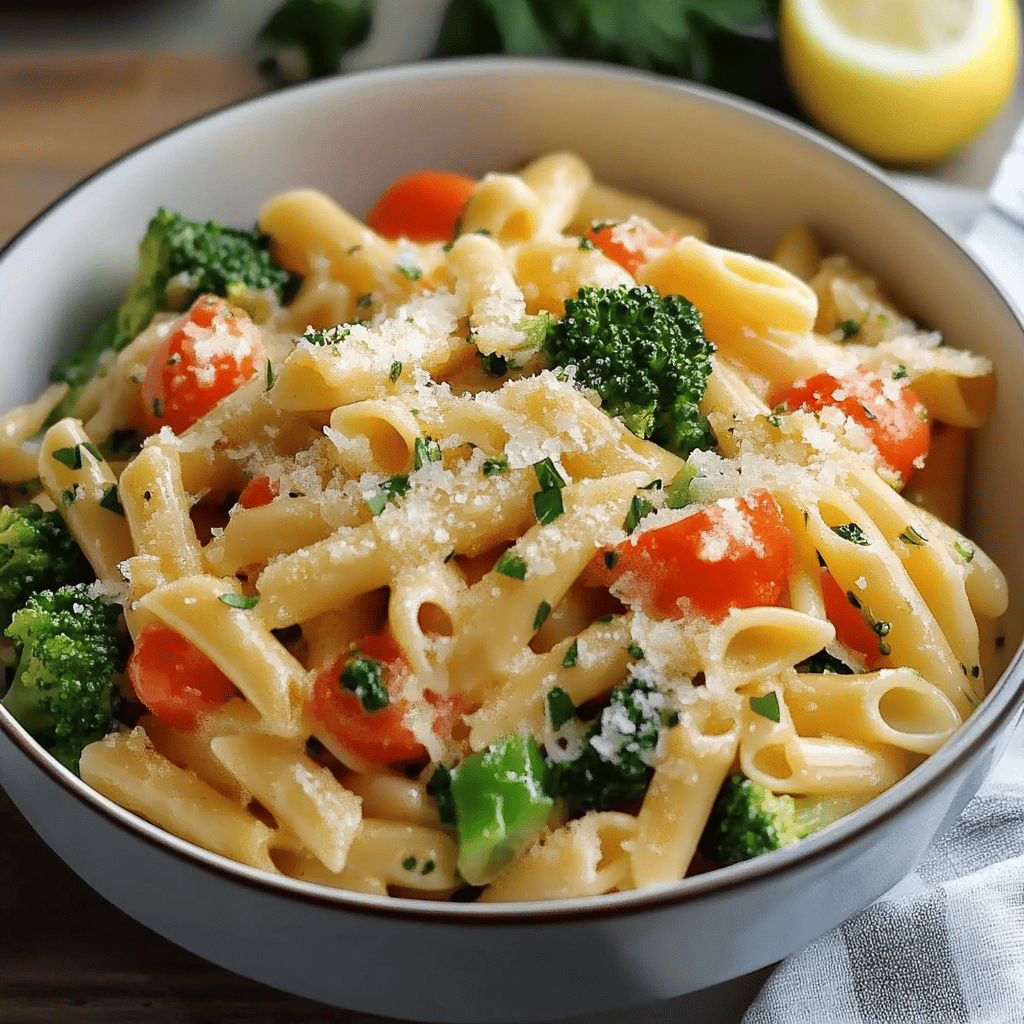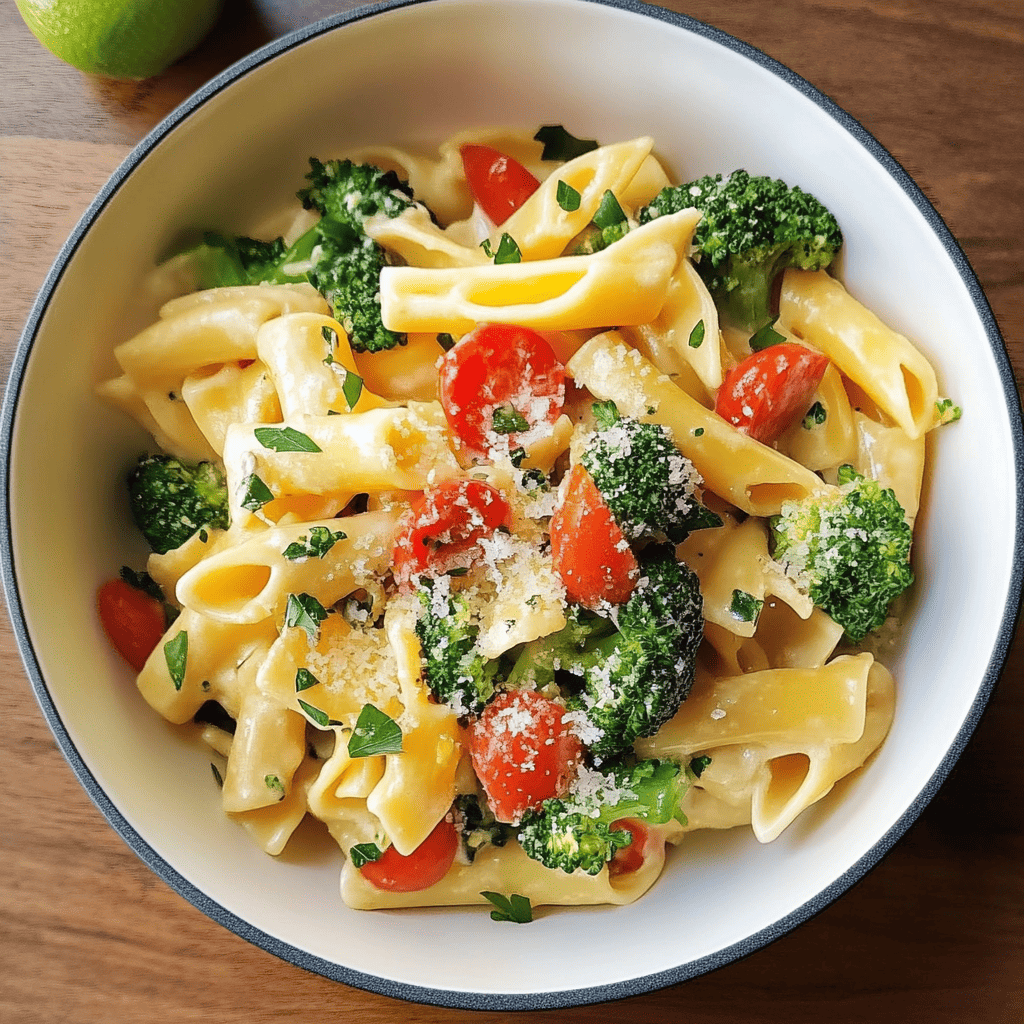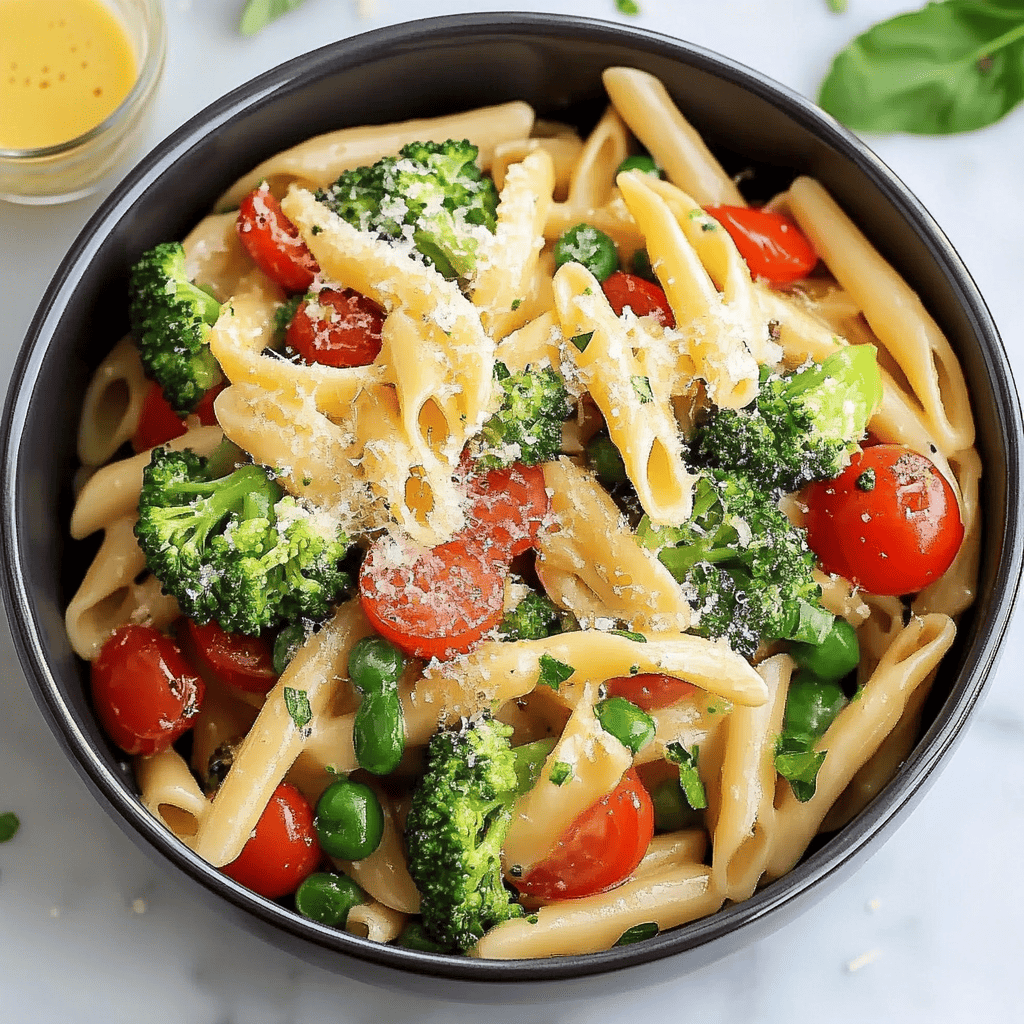Pasta Primavera
Introduction
Pasta Primavera is a colorful, light, and nutritious dish that celebrates the freshness of vegetables. Its origins date back to the 1970s in the United States, despite its Italian name. “Primavera” means “spring” in Italian, referring to the season when fresh vegetables are abundant. This recipe is perfect for those looking for a healthy, quick, and delicious meal without the hassle.
Pasta Primavera is one of those dishes that captivates at first sight and captivates with the first bite. With its burst of color, natural freshness, and mild yet characterful flavor, it has become a classic of light and healthy cuisine. Although its name sounds Italian, its origins date back to the United States, where it emerged as an innovative creation that focused on the use of fresh vegetables and clean flavors .
Ideal for those looking for a quick, tasty, and nutritious option, this recipe combines pasta with a variety of vegetables such as broccoli, carrots, bell peppers, and cherry tomatoes , sautéed in olive oil and seasoned with fresh spices and Parmesan cheese.
Pasta Primavera is more than a recipe: it’s a celebration of simplicity done right , perfect for any time of year, but especially irresistible during spring and summer when ingredients are at their best.

Detailed history of Pasta Primavera
Contrary to popular belief, Pasta Primavera does not originate in Italy, but was created in the United States in the 1970s , in a context of culinary innovation and openness to new flavor combinations.
The most widely accepted story is that the dish was created by chef Sirio Maccioni , founder of the famed Le Cirque restaurant in New York City, and his team. While at a residence in Canada , the chef was looking for a light meal for diners and decided to pair pasta with sautéed fresh vegetables , a combination that was not common on sophisticated menus at the time.
This casual experiment became a resounding success when it was added to Le Cirque’s menu, even though it was initially offered off-menu . The freshness of the ingredients, the simplicity of its preparation, and its healthful nature delighted customers, and the dish soon began to spread throughout New York and then the rest of the country.
In 1977 , the New York Times Magazine published a recipe for Pasta Primavera, helping to catapult its fame nationally and internationally. Since then, it has been replicated, reinvented, and reinterpreted in millions of homes and restaurants.
Why is it called “Spring”?
The word “Primavera” means “spring” in Italian, a season associated with renewal, freshness, and color —qualities that fit perfectly with the dish’s ingredients: seasonal vegetables like carrots, broccoli, peppers, tomatoes, and more.
Evolution of the recipe
The original version also included cream, butter and Parmesan cheese , but over time, many versions have omitted these ingredients to make it lighter or vegan , adapting to current tastes and food trends.
Today, Pasta Primavera is a symbol of the culinary fusion between the classic and the modern, between the nutritious and the tasty, between the quick and the gourmet.
In summary
- Origin: United States, 1970s
- Creators: Sirio Maccioni and his team at Le Cirque
- Popularity: From a 1977 New York Times Magazine article
- Inspiration: Fresh and colorful ingredients, typical of spring
- Legacy: Today it is a modern classic of international cuisine

Ingredients (for 2-3 servings)
- 250g pasta (you can use fettuccine, penne, spaghetti, etc.)
- 1 carrot , cut into half slices
- ½ red pepper , in thin strips
- ¼ cup cherry tomatoes , halved
- ½ cup broccoli , cut into small florets
- 2 cloves of garlic , finely chopped
- 1 handful of fresh parsley , chopped
- 2 tablespoons of extra virgin olive oil
- Salt and pepper to taste
- Grated Parmesan cheese (quantity to taste)
- Juice of half a lemon or a splash of balsamic vinegar (optional, for a fresh touch)
Step-by-step instructions
Cook the pasta
Boil the pasta in salted water according to the package instructions.
Reserve a cup of the cooking water and drain the pasta.
Sauté the vegetables
In a large skillet, heat the olive oil. Add the garlic and sauté for 1 minute, without burning it.
Then add the carrot, bell pepper, cherry tomatoes, and broccoli. Cook over medium heat for 5 to 7 minutes , until cooked but still crunchy.
Mix with the pasta
Add the cooked pasta to the vegetables in the pan. If the mixture is dry, add a little of the reserved water. Stir well to infuse the pasta with the flavor.
Season and finish
Add salt, pepper, chopped parsley, and Parmesan cheese.
If desired, add a few drops of lemon juice or balsamic vinegar to enhance the flavors.
Serves
Serve hot and sprinkle with more Parmesan cheese to taste.
Additional tips
- You can add other vegetables such as zucchini, mushrooms or spinach .
- If you prefer a protein-packed version, add grilled chicken, tofu, shrimp, or chickpeas .
- For a creamier texture, you can add a tablespoon of cream or Greek yogurt.
Benefits of this recipe
- Healthy: Rich in fiber, vitamins and antioxidants.
- Versatile: Adapts to different tastes and diets.
- Quick and easy: Ready in less than 30 minutes.
- Economical: With affordable and fresh ingredients.
Frequently asked questions and more information
What type of pasta is used for Pasta Primavera?
You can use any type of pasta , but long pastas like fettuccine, linguine, or spaghetti are ideal because they trap the vegetables and seasoning better.
Can I make it without cheese or gluten free?
Yes! You can substitute the Parmesan cheese for a vegan version (cashew-based or nutritional yeast-based) and choose gluten-free pasta to suit your diet.
Is it a main dish or a side dish?
Pasta Primavera can work as a main dish on its own, but it is also an excellent side dish for chicken, fish or tofu .
What vegetables can I use?
The most common are broccoli, carrots, bell peppers, zucchini, asparagus, spinach, and cherry tomatoes , but you can use any seasonal vegetables.
Can it be prepared in advance?
Yes. You can cook the vegetables and pasta in advance and reheat everything in a pan just before serving. You can also enjoy it cold as a pasta salad .
Other curiosities about Pasta Primavera
- At the time, it was considered a “revolutionary” recipe for combining Italian cuisine with American influences.
- It doesn’t contain tomato sauce, which makes it lighter and suitable for all tastes.
- It is very popular on vegetarian menus and easily adapts to vegan diets.
Texture and Flavor
- Texture:
- Pasta cooked al dente offers a firm yet soft texture , ideal for supporting the vegetable mixture.
- Sautéed vegetables (such as zucchini, carrots, peppers, broccoli, or peas) add crunch and freshness .
- If you use a light sauce (such as olive oil, cream, or cheese), it adds a creamy or rich layer without overpowering the vegetables.
- Flavor:
- Fresh, light and balanced flavors , where vegetables stand out naturally.
- It can have herbal notes (basil, oregano), citrus or milky , depending on the preparation.
- Adding Parmesan cheese adds a very pleasant salty and umami touch .
Consumer Context
- Typical dish of spring and summer , when vegetables are at their best.
- Perfect as a light meal, healthy lunch or quick dinner .
- Very common in vegetarian diets, although chicken, shrimp or tofu can also be added .
- It is served in both Italian restaurants and homes for its simplicity and versatility .
Visual Aspect
- Very colorful and attractive: includes a variety of vegetables in shades of green, red, orange and yellow.
- The pasta is usually evenly mixed with ingredients, and sometimes topped with grated cheese or fresh herbs .
- It conveys a feeling of a fresh, natural and homemade dish .
Curiosities
- The term “Primavera” is not Italian, but Spanish/Latin , and was adopted to evoke the season and its abundance of vegetation.
- It emerged in the United States in the 1970s as a light interpretation of Italian cuisine.
- Although traditionally made with fettuccine or penne, any type of short or long pasta can be used .
- It is often considered a “fit” or healthy option, ideal for balanced diets .
Estimated Nutritional Value (per 250–300 g serving)
(Version without animal protein and with light sauce)
- Calories: 300 – 450 kcal
- Fat: 10 – 18 g (more if it contains cream or cheese)
- Carbohydrates: 40 – 55 g
- Protein: 8 – 12 g
- Fiber: 4 – 8 g (from vegetables)
- Vitamins: A, C, K, B complex (from the variety of vegetables)
- Sodium: Low to moderate (depending on the sauce)
Other Interesting Information
- You can prepare vegan, gluten-free, or high-protein versions depending on the type of pasta and accompaniment.
- It keeps very well for the next day, even as a cold pasta salad .
- Some versions include a touch of grated lemon or juice , which further highlights the freshness of the dish.
- It is ideal for taking advantage of seasonal vegetables or leftovers from the refrigerator .

Conclusion
Pasta Primavera is much more than a vegetable pasta dish: it’s a celebration of color, freshness, and balance . Ideal for those who want to eat well without complications. Whether as a main course or a side dish, its light yet characterful flavor will win everyone over .
Go ahead and prepare it and fill your table with color and flavor!
Pasta Primavera is a perfect example of how simple cooking can also be elegant, flavorful, and nutritious . Its success is due not only to its fresh flavor but also to its ability to adapt to any lifestyle or diet. This recipe allows you to experiment with ingredients, colors, and textures, making each dish a unique creation.
Plus, it’s a great way to introduce more vegetables into our daily diet without sacrificing the pleasure of eating. Whether for a quick weeknight dinner, a special lunch, or a cookout, Pasta Primavera is always a winning choice.
In short: it’s a dish that combines the best of home cooking with the creative spirit of contemporary gastronomy. Simple, versatile, and absolutely delicious. A recipe always worth repeating!

